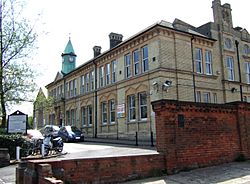Penge Urban District facts for kids
| Penge | |
 Penge Vestry Hall was built in 1878 |
|
| Geography | |
| Status | Civil parish (1866–1965) Urban district (1900–1965) |
| 1911 area | 770 acres (3.1 km2) |
| 1961 area | 769 acres (3.1 km2) |
| HQ | Town Hall, Anerley Road |
| History | |
| Origin | Detached hamlet of Battersea |
| Created | 1866 |
| Abolished | 1965 |
| Succeeded by | London Borough of Bromley |
Quick facts for kids Demography |
|
|---|---|
| 1911 population - 1911 density |
22,330 29/acre |
| 1961 population - 1961 density |
25,743 33/acre |
| Politics | |
| Governance | Penge Urban District Council (1900–1965) |
Penge was a special area in southeast London, England. It used to have its own local government. This area included the towns of Penge, Anerley, and part of Crystal Palace.
Penge was part of the London postal area and the police district. From 1933, it was also part of the London public transport network. In 1965, Penge's local government was stopped. It then became part of a bigger area called Greater London. Penge joined with other districts to form the London Borough of Bromley.
Contents
Penge's Early History
Penge started as a small, separate village. It was part of a much older area called Battersea. Battersea was located in a county called Surrey.
Penge in the Big City
In 1855, Battersea became part of the area managed by the Metropolitan Board of Works. This board helped run London. The main part of Battersea joined the Wandsworth District. Penge, however, became part of the Lewisham District.
In 1870, Penge also joined the London School Board area. This board was in charge of schools. Penge was part of the Croydon Poor Law Union. This meant it was linked to Surrey for helping people in need.
Even though Penge was formally part of Battersea, it started to manage its own money and local services in 1859. In 1866, Penge officially became its own separate civil parish. A civil parish is a local area with its own council. In 1876, Penge built its own local government building, called the Penge Vestry Hall.
Penge Changes Counties
From 1889, Penge was part of the County of London. In 1900, new rules changed how local government worked in London. These rules were part of the London Government Act 1899.
There were discussions about what should happen to Penge. It could join other parts of London, like Camberwell or Lewisham. It could also join the County Borough of Croydon. Or, it could become its own self-governing area, called an urban district, in Surrey or Kent.
A meeting was held in Penge in 1899 to decide this. Many groups shared their opinions. The London County Council wanted Penge to stay in London. The Crystal Palace Company also agreed. Surrey County Council did not want Penge. They thought it would be too hard to manage if it became an urban district in Surrey. Kent County Council was happy to take Penge into their area.
The local Penge council preferred to join Surrey. Their next choices were Kent or joining Croydon. Joining Camberwell was their least favorite option. People at the meeting talked about taxes and pub closing times. They also wanted Penge to be able to govern itself. In the end, Penge was moved to Kent and became an urban district.
Voting for Penge
From 1885, Penge was part of the Dulwich area for choosing members of parliament. These are people who represent the area in the national government. Penge was also part of the Dulwich area for elections to the London County Council. This happened in 1889, 1892, 1895, and 1898.
Penge's End as a District
In 1965, Penge's urban district government was officially ended. This was due to the London Government Act 1963. Penge's area then became part of Greater London. It joined with other districts to create the London Borough of Bromley that we know today. The old town hall in Penge is still used. It now holds offices for Bromley's social services and housing departments.

